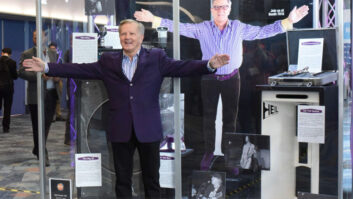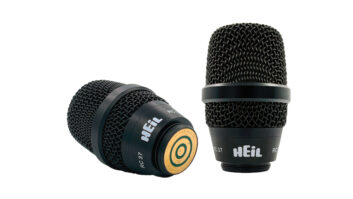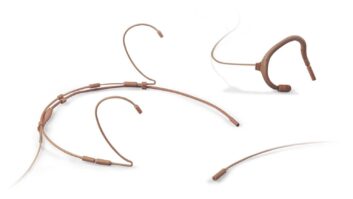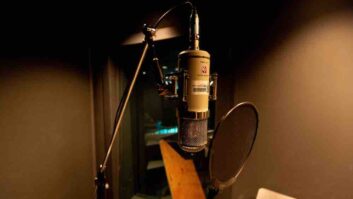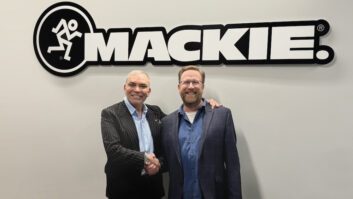
Even though the Heil PR30 (right) and PR40 large-diaphragm dynamic mics look like side-address models, they are front-firing. The PR30 is 6.5×1.75 inches, weighs in at a trim 9 ounces and uses a large 1.5-inch transducer. Its shape, weight and sturdy standmount allow you to tuck the mic into tight spaces without fearing that it will sag or get in the way of drums or other adjacent mics. The slightly larger (6.75×2.10-inch) PR40 weighs 13.5 ounces. Although the PR40 is larger, it uses a smaller 1.13-inch element.
The mics each have two different-diameter mesh screens and a “breath blast” filter to keep pops to a minimum during voice applications. The elements are isolated via a Sorbothane shock-mount on top of a non-resonant fixture, which effectively de-couples the elements from the steel case.
Both come in a matte-champagne finish and include well-designed, burly standmounts. The PR40 (below) arrives in a metal “lunchbox” case with a handle; the PR30 ships in a box surrounded by foam. An optional SM2B shock-mount fits either mic.
GOING PRIME-TIME
One way to harvest great tones from a drum kit is to mike the toms’ top and bottom heads. The PR30 and PR40 worked well as a team on a low tom, with the PR30 on top and the PR40 providing added low tone from underneath. When I flipped the polarity on the bottom mic, which is naturally out of polarity due to its opposite placement, the sound was thunderous. Stick attack and transient response from the PR30 had the tom sounding great on top, while the feed provided by the PR40 from the bottom added lots of warm low-frequency tone to the mix, making it a winner in this application.

One remarkable thing I noticed was that the PR30 has a tendency to round out the transient in a beneficial way, almost as though it mildly compresses the signal. This was subtle, yet noticeable in a number of high-transient applications. Heil claims that this sounds like the response you would get from a ribbon mic, and I’d have to agree that the effect is similar to that.
I then used the PR30 on a snare drum with good results. The mic has plenty of great-sounding upper-mids and top end for a dynamic model, and reacted well when I tried to dig out 150 Hz to make the bottom end of this thin snare sound a bit bigger. As mentioned, the mic has a tendency to round out transient hits when used with a high-SPL source, and the snare was no different. When I added a Shure SM81 to the bottom of the drum and flipped the polarity to pick up the snare component, it mixed very well with the PR30, providing plenty of snap to the drum and overall mix. Using the PR40 on the same snare, I noticed it offered more bottom end than the PR30.
The PR30 sounded great on a Fender SuperSonic guitar cabinet with a single 12-inch speaker. Both mics were equidistant from the grille cloth and about four inches off the edge of the dust cone. I first isolated both mics to hear the difference. The PR30 had a bit more top end and was more balanced through the spectrum, while an SM57 sounded thicker in the lower midrange. When I added them together, it was the perfect marriage: The PR30 made up for the upper-mids and top end that was lacking on the 57, while the 57 brought up the lower-mids.
HEIL-Y DELICIOUS
After talking to Bob Heil about his mic line during this year’s NAB show in Las Vegas, I was intrigued. If you have ever met him, then you know that he’s quite the evangelist for his mics. I tend to leave my hype filter set on high for any review, and I must admit I was a bit skeptical about his claims, but I couldn’t have been more wrong. The PR30’s promised “ribbon-y” response was borne out in repeated applications. Used on various drums, guitar cabinets and vocals, the tone was stellar.
The PR30 and PR40 are brawny units, with beefy mounts, steel bodies and sturdy grilles that would probably survive a tumble, although that wasn’t part of the test. They sound great in the usual high-SPL applications where you’d imagine a dynamic to shine and are quite affordable. If you’ve ever thought that dynamic mics were dull workhorses, then you need to check out these Heil mics. Prices: PR30, $299; PR40, $375; and SM2B shock-mount, $95.
Heil Sound, 618/257-3000; www.heilsound.com.
Kevin Becka is Mix’s technical editor.
